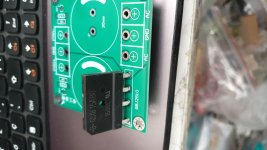Hi.I received bridge diodes from China.I just want to know can i use GSIB15A80 instead of GBJ2510 because i already have GSIB15A80 in hand? I think nobody can draw such high current from single 35mm capacitors.I also want to sell some of them.Do you think customers may cause problems?Thanks
Attachments
If you draw less than 15A yes.
No idea on the second part of your question as I have no idea what the purpose is and whether it is a critical item or not.
No idea on the second part of your question as I have no idea what the purpose is and whether it is a critical item or not.
if you think the 10amp difference in device rating is not going to matter to what your building go ahead and sub it.
are the caps the only load?
are the caps the only load?
I think this pcb is made for audio amplifiers.And GSIB15A80 bridge diodes can also give very high pulse currents (200A IFSM) that amplifier can not surge.
I've had bridge rectifiers fail due to the inrush currents of the main reservoirs.
The higher the current, the more reliable they are likely to be.
To be on the safe side do your calculations based on (1) Maximum mains Voltage, (2) Full In-rush current at peak of mains sine wave and (3) The biggest capacitors that you are likely to encounter +20%.
In my failure 3 x 33000uF (100 000uF) caps drew enough start-up current to destroy a 50A rectifier.
The higher the current, the more reliable they are likely to be.
To be on the safe side do your calculations based on (1) Maximum mains Voltage, (2) Full In-rush current at peak of mains sine wave and (3) The biggest capacitors that you are likely to encounter +20%.
In my failure 3 x 33000uF (100 000uF) caps drew enough start-up current to destroy a 50A rectifier.
Last edited:
When one uses a very high capacitance like 0.1F as mentioned in the previous post, it is important to limit the inrush current with either a resistance or an inductor. Both of these can be shorted as soon as the rail voltage reaches a preset but safe value. I have seen circuits like these. There is also the option of using a temperature dependent resistor with a strong negative temperature coefficient.
